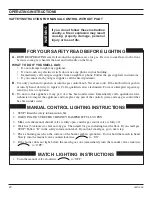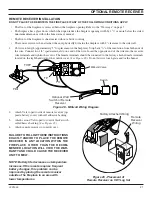
32D1999
9
CONNECTING THE GAS
Pipe Coupling
To Gas Log
Regulator
Manual Shutoff
Valve
Gas Supply Inlet
Figure 5 - Gas Connection
Pipe
IMPORTANT:
Hold appliance regulator firmly with a wrench to prevent movement when connecting to inlet piping.
Check gas type:
The gas supply must be the same as stated on the gas logs rating plate. If the gas supply is different,
DO
NOT INSTALL THE GAS LOGS.
Contact your dealer for the correct model.
Always use an external regulator for all propane/LPG gas logs only,
to reduce the supply tank pressure to a maximum of
13" w.c. This is in addition to the regulator fitted to the gas log set. High pressure natural gas systems require a regulator to
reduce supply pressure to 10" W.C.
Locations that the Pressure Tapping
Point May be Installed
NOTICE: A qualified gas appliance
installer must connect the appliance
to the gas supply. Consult all local
codes before installation.
NOTICE
Use new black iron pipe, steel pipe, copper tubing, or internally tinned copper tubing.
Copper or internally tinned copper tubing can only be used according to the National
Fuel Gas Code, section 2.6.3, providing gas meets sulfide limits, and where permitted
by local codes. Gas piping system must be sized to provide minimum inlet pressure
(listed on Data Plate) at the maximum flow rate (BTU/Hr). Undue pressure loss will occur
if the pipe is too small.
A manual shutoff valve must be installed upstream of the appliance. Union tee and
plugged 1/8" NPT pressure tapping point should be installed upstream of the appliance.
Refer to
Figure 5.
CAUTION
Connecting directly to an
unregulated propane/LPG tank can
cause an explosion
W
ARNING
Содержание VDY24/18
Страница 29: ...32D1999 29 NOTES ...
Страница 30: ...30 32D1999 NOTES ...
Страница 31: ...32D1999 31 NOTES ...










































